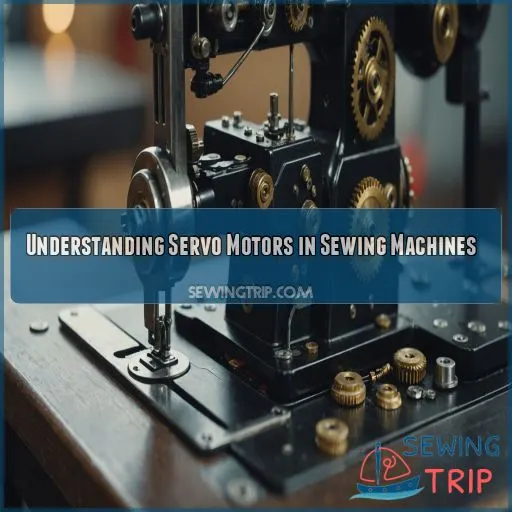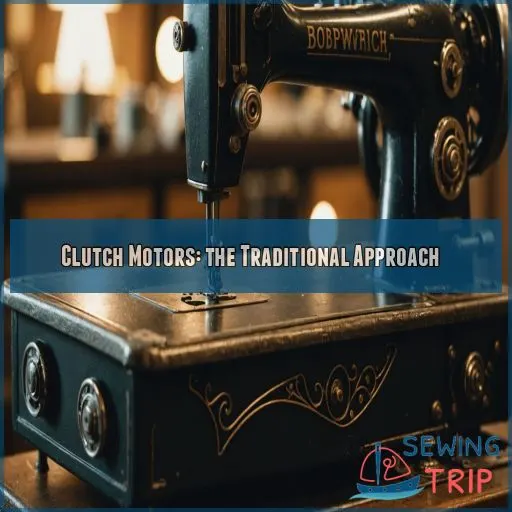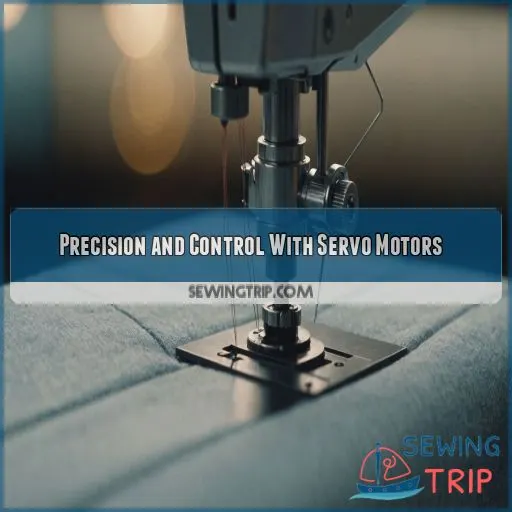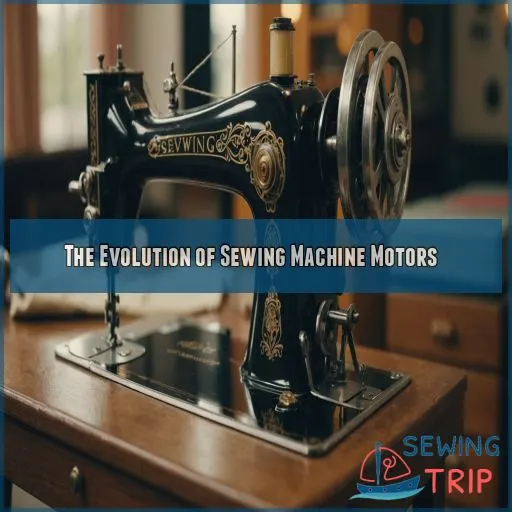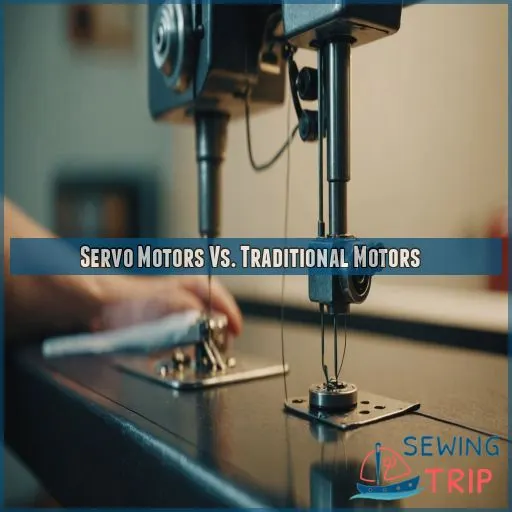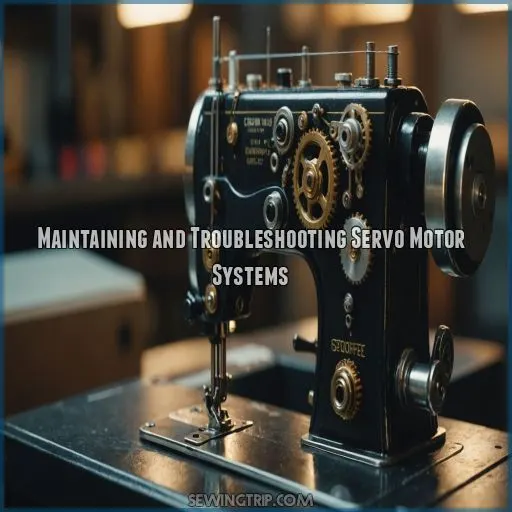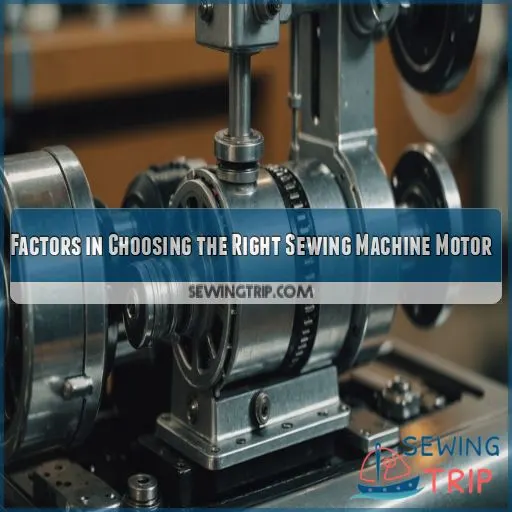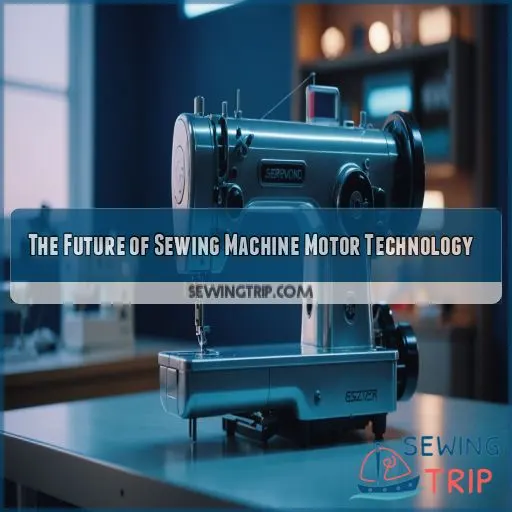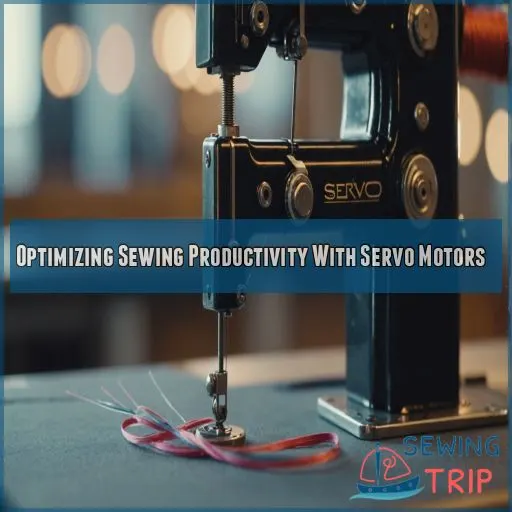This site is supported by our readers. We may earn a commission, at no cost to you, if you purchase through links.
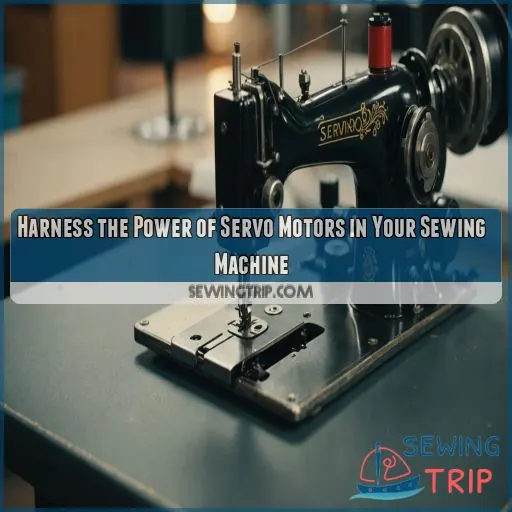 A servo motor? It’s like the secret superpower of your sewing machine!
A servo motor? It’s like the secret superpower of your sewing machine!
These little guys use computer-powered feedback to give you pinpoint control over speed and positioning.
Gone are the days of fighting with a finicky clutch motor – servo motors let you sew with the precision of a surgeon, gliding effortlessly through delicate fabrics and maneuvering through tight turns with ease.
Plus, they come packed with automated features to boost your productivity, from thread trimming to perfect backtacking.
It’s like having a personal sewing assistant at your fingertips.
Table Of Contents
- Key Takeaways
- Understanding Servo Motors in Sewing Machines
- Clutch Motors: the Traditional Approach
- Precision and Control With Servo Motors
- The Evolution of Sewing Machine Motors
- Servo Motors Vs. Traditional Motors
- Maintaining and Troubleshooting Servo Motor Systems
- Factors in Choosing the Right Sewing Machine Motor
- The Future of Sewing Machine Motor Technology
- Optimizing Sewing Productivity With Servo Motors
- Frequently Asked Questions (FAQs)
- Conclusion
Key Takeaways
- Ditch your old clutch motor and embrace the power of servo motors – these computerized wonders offer pinpoint control over speed and position, letting you sew like a pro and handle even the most delicate fabrics with ease.
- Say goodbye to tedious manual adjustments – servo motors pack a suite of smart, automated features that’ll boost your productivity, from thread trimming to perfect backtacking. It’s like having a personal sewing assistant at your fingertips!
- Don’t be intimidated by servo motors – these high-tech marvels are seamlessly integrated into modern sewing machines, offering unprecedented control and precision for your projects, from intricate seam finishing to speedy, consistent straight lines.
- With servo motors, you’ll enjoy precise speed control, enhanced fabric handling, and energy-efficient performance that’ll save you money on your electricity bills. It’s a win-win for your sewing and your wallet!
Understanding Servo Motors in Sewing Machines
Are you ready to harness the power of servo motors and transform your sewing experience?
Understanding these advanced motors is the key to achieving precision, speed, and productivity in your projects.
Definition and Mechanism of Servo Motors
Servo motors are the backbone of modern sewing machines.
They offer a level of control that clutch motors simply can’t match.
These computerized DC motors use a feedback loop to precisely govern speed and position, allowing you to sew like a pro.
Whether you’re tackling a delicate chiffon or thick denim, servo motors provide the precision you need.
Advantages of Servo Motors Over Clutch Motors
Ditch the old-school clutch motors and embrace the power of servo motors to elevate your sewing game.
Servo motors offer several benefits that can take your sewing to the next level. These benefits include:
- Precise speed control for intricate projects.
- Enhanced fabric handling for professional results.
- Automated features that save time and boost productivity.
- Long-term efficiency gains that offset the initial investment.
Servo Motor Types: Brushed Vs. Brushless
Brushed models are typically more affordable.
However, brushless variants pack more punch with their longer lifespans and quieter operation.
Whichever you choose, be mindful of maintenance needs to keep your sewing machine humming along smoothly.
Integration of Servo Motors in Sewing Machine Design
You’ve always relied on your trusty sewing machine, but did you know that the secret to its power lies in the humble servo motor?
These high-tech wonders are seamlessly integrated into modern sewing machines, offering unprecedented control and precision.
From backtacking to needle positioning, servo motors transform your sewing experience, opening up a world of creative possibilities.
Clutch Motors: the Traditional Approach
If you’ve been sewing for a while, you’ve probably encountered the trusty clutch motor – the old standby in many older sewing machines.
While they may not offer the precision of modern servo motors, clutch motors are simple, reliable workhorses that excel at longer, straight seams on heavy fabrics.
How Clutch Motors Operate
Traditional clutch motors employ a simple, reliable clutch mechanism to harness the power of AC current and reach full speed swiftly.
These trusty motors run at a constant velocity regardless of pedal pressure.
They thrive when tackling longer, straight seams, making them perfect for heavyweight materials like leather or upholstery.
However, they lack fine-tuned speed control.
Benefits of Clutch Motors for Specific Sewing Tasks
If you’re sewing large, heavy projects like bedsheets or harnesses, clutch motors shine. Their consistent speed makes long, straight seams a breeze.
Clutch motors have several benefits that make them ideal for certain sewing tasks. They are:
- Well-suited for heavy fabrics
- Great for continuous sewing tasks
- Reliable and easy to use
- Compatible with vintage sewing machines
Drawbacks of Clutch Motors
While clutch motors have their advantages, they do come with some notable drawbacks.
Without precise speed control, it can be tricky to navigate delicate curves or intricate stitches.
Their old-school design also makes them prone to overheating, especially when pushing them to their limits.
Additionally, the racket they produce can be a nuisance in quieter sewing spaces.
Servo motors offer a smoother, smarter solution.
Precision and Control With Servo Motors
Upgrade your sewing game with servo motors! These computerized powerhouses offer precise speed control, letting you breeze through projects with unparalleled precision and productivity.
Precise Speed Adjustment Capabilities
With servo motors, you enjoy precise speed control at your fingertips.
Whether you’re delicately stitching fine fabrics or powering through heavy-duty projects, you can fine-tune your sewing speed from a crawl to a sprint.
This versatility lets you master every stitch, from the most intricate seam finishing to speedy, consistent straight lines.
Enhanced Fabric Handling and Productivity
With a servo motor, you’ll have precision control that’ll transform your sewing.
Forget fumbling – your fabric will glide effortlessly, and your seams will be impeccable.
Boost Your Productivity
Boost your productivity by minimizing mistakes and wasted time. It’s like having a sewing superpower at your fingertips.
Get ready to sew circles around your old machine.
Automated Functions Enabled by Servo Motors
Gone are the days of tedious manual adjustments.
Servo motors empower your sewing machine with a suite of smart features that streamline your workflow.
Automatic thread trimming, precise needle positioning, and effortless backtacking are some of the automated functions that elevate your sewing game.
These automated functions free up your hands to focus on the intricate art of fabric handling.
The Evolution of Sewing Machine Motors
The evolution of sewing machine technology has transformed the way we create.
From manual foot pedals and hand cranks to today’s integrated, computerized motors, sewing machines have undergone significant advancements.
As you journey through the advancements in sewing machine motors, prepare to harness the power and precision that modern servo motors can bring to your sewing projects.
From Manual to Electric Power
Rewind the clock a century, and you’d find sewing machines powered not by electricity, but by your own two hands.
These early machines, which included hand cranks and treadle-operated models, paved the way for the seamless electric marvels we enjoy today.
As technology advanced, motors became integrated, streamlining the experience and paving the path to direct drive innovation.
Integrated and Enclosed Motor Designs
Your sewing machine’s motor has come a long way from the bulky, external units of the past.
These days, motors are seamlessly integrated into the machine’s casing, making them more compact and user-friendly.
Fully enclosed designs also help reduce noise and keep your workspace tidy.
With these streamlined improvements, you can focus on your craft without distractions.
Emergence of Direct-Drive Motors
Direct-drive motors emerged as a game-changer in the evolution of sewing machine technology, a significant advancement.
These efficient powerhouses connect directly to the drive shaft, eliminating transmission losses.
They deliver consistent speed, high torque, and whisper-quiet operation, making them perfect for industrial sewing applications.
In these applications, precision and productivity reign supreme, making direct-drive motors an ideal choice.
Servo Motors Vs. Traditional Motors
If your sewing machine is still powered by an old-school clutch motor, you’re missing out on the precision and performance that modern servo motors can deliver.
From fine-tuned speed control to energy-efficient operation, servo motors offer a host of advantages that can revolutionize your sewing experience.
Key Differences in Mechanism and Performance
If you’re looking at sewing machine motors, the differences are like night and day.
Clutch motors are the old faithful – straightforward and reliable, but with less precise speed control.
Servo motors, on the other hand, are the high-tech wizards, offering pinpoint speed adjustments and seamless automated features.
Efficiency and Energy Savings With Servo Motors
One key advantage of servo motors is their impressive efficiency.
Compared to traditional clutch motors, servo motors can save you a bundle on energy costs.
Their precise speed control means less thread waste and longer lifespan.
Imagine the savings when your machine intelligently adapts power usage based on IoT connectivity – that’s a sewing room upgrade you’ll love.
Compatibility With Advanced Sewing Features
Servo motors are a step above traditional motors for advanced sewing features.
They open up a world of creativity and efficiency.
Automatic needle threading, embroidery capabilities, buttonhole automation, and thread trimming become a breeze.
The smooth foot pedal control gives you the command and confidence you crave.
Maintaining and Troubleshooting Servo Motor Systems
Owning a sewing machine with a servo motor comes with great power – and great responsibility.
Keeping your servo motor running smoothly takes a little know-how.
We’ve got your back with expert tips on maintaining and troubleshooting this high-tech powerhouse.
Understanding Motor Maintenance Requirements
Keeping your servo motor humming along seamlessly requires a little TLC.
Lubricate the moving parts according to the manufacturer’s instructions to maintain smooth operation.
Regularly clean dust and debris from the motor housing to prevent overheating.
Don’t forget to check for any unusual noises – that could be an early warning sign of trouble.
With a bit of tender loving care, you’ll extend your servo motor‘s lifespan and sewing prowess.
Diagnosing and Resolving Servo Motor Issues
Is your servo motor acting up? Don’t sweat it – we’ve got your back!
Start by checking for common issues like unusual noises, overheating, or inconsistent speed.
Diagnose the problem by:
- Inspecting for loose connections or obstructions
- Monitoring power supply and cooling functionality
- Ensuring software/firmware are up-to-date
With a bit of troubleshooting, you can get that servo humming again in no time!
Selecting Replacement Parts for Servo Motors
Finding the right replacement parts for your servo motor can seem tough, but don’t worry – we’ve got your back.
From compatibility to brand, cost, and even warranty coverage, use this handy table to find the perfect fit and keep your machine humming.
With a little research, you’ll be sewing like a pro in no time.
| Factor | Considerations |
|---|---|
| Compatibility | Make sure the part matches your specific sewing machine model |
| Brand | Opt for the manufacturer’s recommended components for best results |
| Cost | Balance quality and budget to find the sweet spot |
| Warranty | Look for parts with generous coverage to protect your investment |
Factors in Choosing the Right Sewing Machine Motor
Choosing the right sewing machine motor is really important to tackling your projects with ease.
Whether you’re a seasoned pro or just starting out, understanding the key factors in motor selection will empower you to make the most of your sewing machine’s capabilities.
Suitability for Specific Sewing Projects
Your sewing machine’s motor matters more than you think.
Whether you’re tackling heavy-duty projects like saddles or delicate tasks like embroidery, the right motor can make all the difference.
Here are 3 key factors to keep in mind:
- Fabric Weight: Clutch motors shine for thick materials, while servo motors excel at precise control for lightweight fabrics.
- Seam Complexity: Clutch motors deliver consistent speed for long, straight seams, while servo motors offer superior maneuverability for intricate garment construction and quilting.
- Project Duration: Clutch motors handle marathon sewing sessions with ease, while servo motors prevent fatigue during shorter bursts of activity.
Considerations for Heavy-Duty Applications
If you’re tackling hefty sewing projects like leather, denim, or thick upholstery, you’ll need a motor with serious power.
You’ll need a servo motor that boasts high torque to effortlessly pierce through dense fabrics without lugging or stalling.
Pair it with a needle strong enough to handle the strain, and you’re good to go!
Evaluating Motor Compatibility With Machine Features
When choosing the right sewing machine motor, weigh the machine’s capabilities.
Will it handle your preferred stitch types and fabric weights?
Can it precisely control needle positioning, tension, and foot pressure for professional-looking results?
Consider how the motor’s features – speed, torque, and automation – align with your sewing needs for a seamless experience.
The Future of Sewing Machine Motor Technology
Sewing machine technology is constantly evolving.
The future holds even more exciting advancements.
Brushless servo motors, advanced electronic controls, and IoT connectivity are paving the way for unparalleled precision, efficiency, and smart features in your sewing machine.
Advancements in Brushless Servo Motor Design
Upgrading to a brushless servo motor opens up a whole new world of possibilities for your sewing machine.
These advanced motors boast impressive efficiency, delivering more power with less energy.
Their superior torque control and extended lifespan make sure your machine hums along smoothly, even through your most ambitious projects.
Whisper-quiet operation and enhanced heat dissipation make for an unparalleled sewing experience.
Integration of Electronic Controls and IoT Connectivity
Imagine your sewing machine becoming a smart, data-driven companion.
By integrating electronic controls and IoT connectivity, you can:
- Monitor its performance
- Adjust settings remotely
-
Automate custom stitching patterns
All with a few taps on your smartphone.
Embrace the future of sewing, where technology empowers your creativity and efficiency.
Focus on Energy Efficiency and Sustainability
As the world grows more eco-conscious, you’ll be pleased to know that the latest sewing machine motors prioritize energy efficiency and sustainability. Gone are the days of power-hungry motors – these modern marvels boast impressive energy savings, slashing your utility bills while reducing your carbon footprint. What’s not to love?
| Feature | Benefit |
|---|---|
| Optimized Power Consumption | Reduced energy costs and environmental impact |
| Efficient Motor Design | Longer lifespan and fewer maintenance needs |
| Regenerative Braking | Recaptures energy during deceleration |
| IoT Connectivity | Real-time performance monitoring and optimization |
| Recyclable Components | Easier disposal and eco-friendlier lifecycle |
Optimizing Sewing Productivity With Servo Motors
Ditch your old clutch motor and boost your sewing machine’s performance with servo technology.
This upgrade offers several benefits, including precise speed control and enhanced fabric handling.
With servo technology, you can also enjoy time-saving automated functions that will have your projects zipping along in no time.
Increased Precision and Speed Control
Servo motors give you complete control over your sewing speeds.
You can dial in the perfect pace for each project.
Whether you’re stitching delicate chiffon or sturdy denim, servo motors offer the precision control to maintain consistent stitch quality and seam perfection.
This means you can sew with confidence from start to finish.
Enhanced Fabric Handling and Reduced Errors
Servo motors are your secret weapon for smooth sewing, even on the most delicate fabrics.
Say goodbye to frustrating puckering and uneven stitches.
Servo motors empower you to:
- Precisely control fabric tension for a professional finish.
- Effortlessly navigate tricky curves and corners.
- Detect and correct errors before they become an issue.
Automated Functions and Time-Saving Features
Don’t waste another second on tedious sewing tasks – servo motors have your back!
Take advantage of automated backtacking, thread trimming, and even buttonhole creation.
Precision needle positioning and self-adjusting tension mean you can focus on the fun stuff.
Check out this handy table to see how servo motors can streamline your sewing:
| Feature | Benefit |
|---|---|
| Automated Backtacking | Effortless reinforcement of seam ends |
| Thread Trimming | Say goodbye to snipping threads |
| Needle Positioning | Perfect placement for every stitch |
| Buttonhole Creation | Professional results with the push of a button |
| Auto-Tension Adjustment | Consistent tension, no more tangles |
Frequently Asked Questions (FAQs)
What is the purpose of the servo motor?
The servo motor is an absolute game-changer, giving you pinpoint control over your sewing speed like never before.
Bye-bye clutch motor – this brushless beauty lets you sew with the precision of a brain surgeon.
What is the difference between servo motor and clutch motor for sewing machines?
Clutch motors offer consistent, reliable speed for basic sewing tasks.
Servo motors deliver precise speed control and advanced features like backtacking and thread trimming.
These features are perfect for intricate projects and boosting productivity.
What is the main difference between a servo motor and a normal motor?
Servo motors are the MVPs of sewing machines, giving you the power to control speed like a pro.
Unlike ol’ reliable clutch motors, these electronic wonders let you finesse the pedal to a T – no more surprises on the fabric highway!
Why would you use a servo instead of a motor?
Servo motors are like your sewing machine’s superpower – they give you the control and precision you crave.
Servo lets you dial in the perfect speed for every stitch, making your projects look professional and pristine.
How do servo motors adjust sewing speed?
Don’t worry, those complicated servo motors aren’t as intimidating as they seem.
They let you effortlessly dial in the perfect sewing speed.
This means you can tackle any project with precision and control.
It’s like having a personal sewing butler at your fingertips!
What are the main components of a servo motor system?
The key components of a servo motor system are the motor itself, an electronic controller, and position feedback sensors.
These components work together to give you precise, responsive control over your sewing machine’s speed and power.
How do servo motors compare to stepper motors?
You’ll go gaga over servo motors, friend!
They’re the cream of the crop – far snazzier than those old-school stepper motors.
They’re so slick, you’ll be sewing like a pro in no time flat!
What are the common servo motor failure modes?
Servo motors can fail due to overheating, bearing issues, encoder errors, or electrical problems.
Overheating, bearing issues, encoder errors, and electrical problems are common reasons why servo motors might fail.
But don’t worry – with proper maintenance and troubleshooting, you can extend their lifespan and keep your sewing machine humming along smoothly.
Can servo motors be retrofitted on older sewing machines?
Is your vintage sewing machine feeling sluggish?
Don’t worry, you can often retrofit a snazzy servo motor to give it a new lease on life.
It takes a bit of know-how, but it’s well worth the effort.
Conclusion
With servo motors, your sewing machine transforms into a nimble sidekick, gliding effortlessly through the most demanding fabrics.
Harness this supercharged tech to sew with the precision of a surgeon, trimming threads, backtacking perfectly, and nimbly maneuvering through tight turns.
Whether you’re a seasoned pro or a novice, a servo motor on your sewing machine puts unparalleled power and control right at your fingertips.

